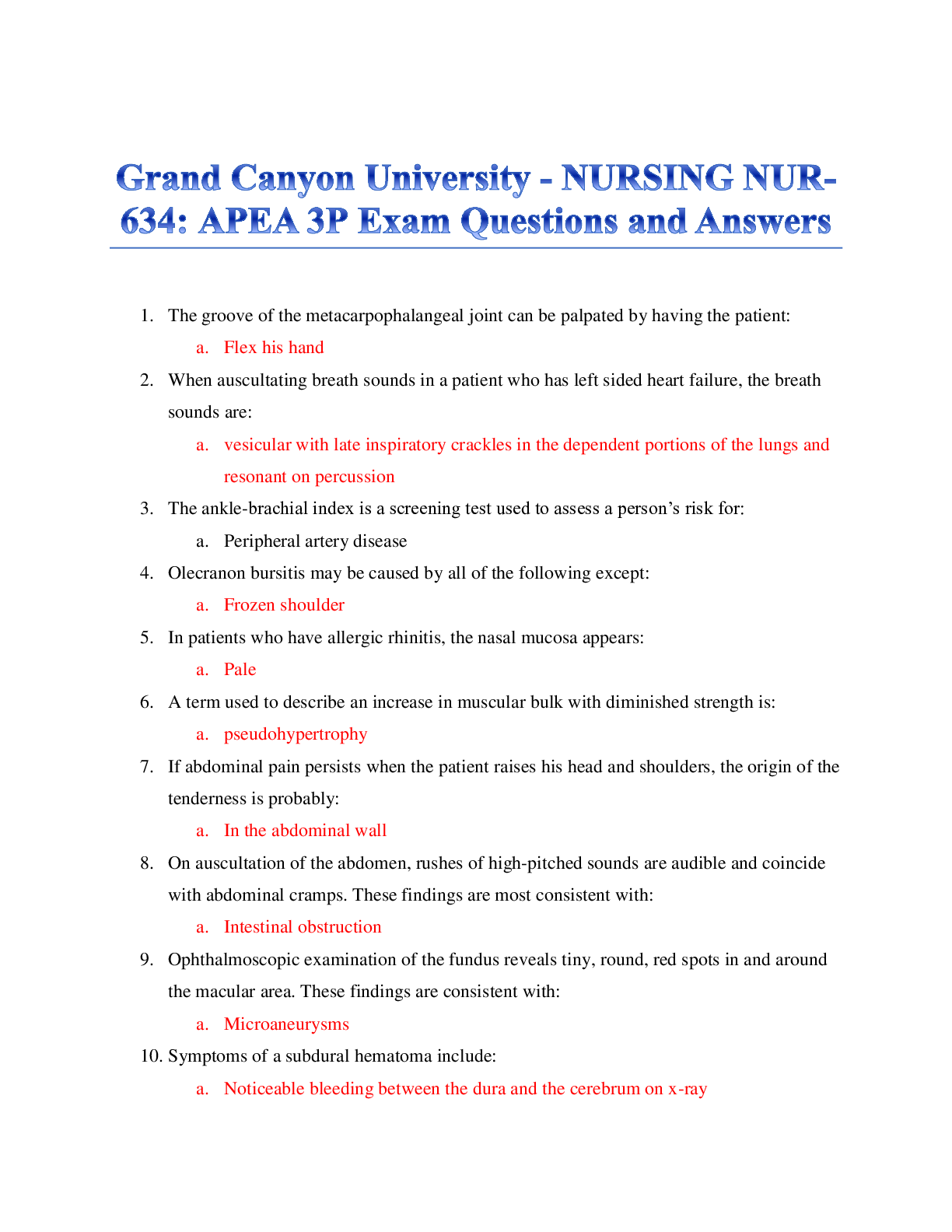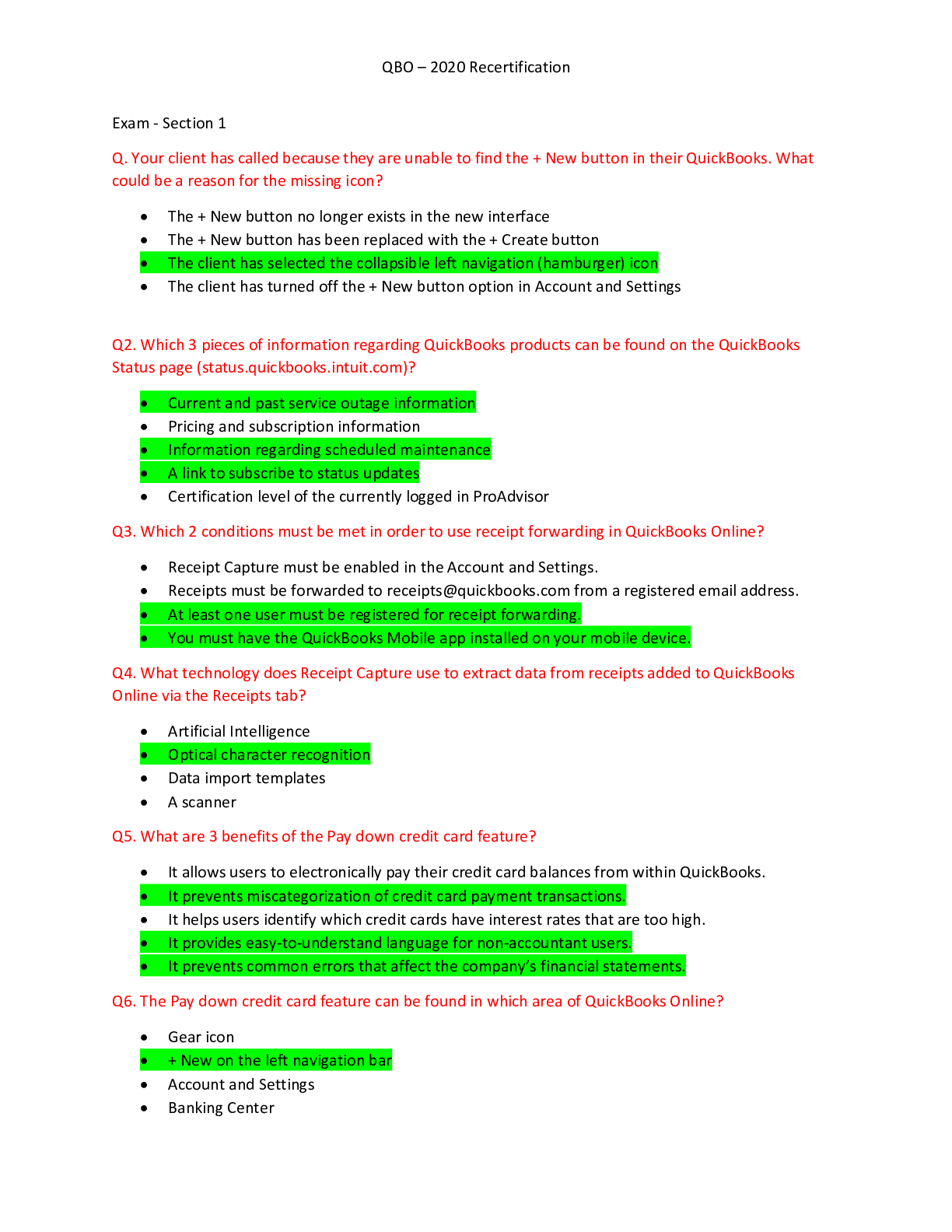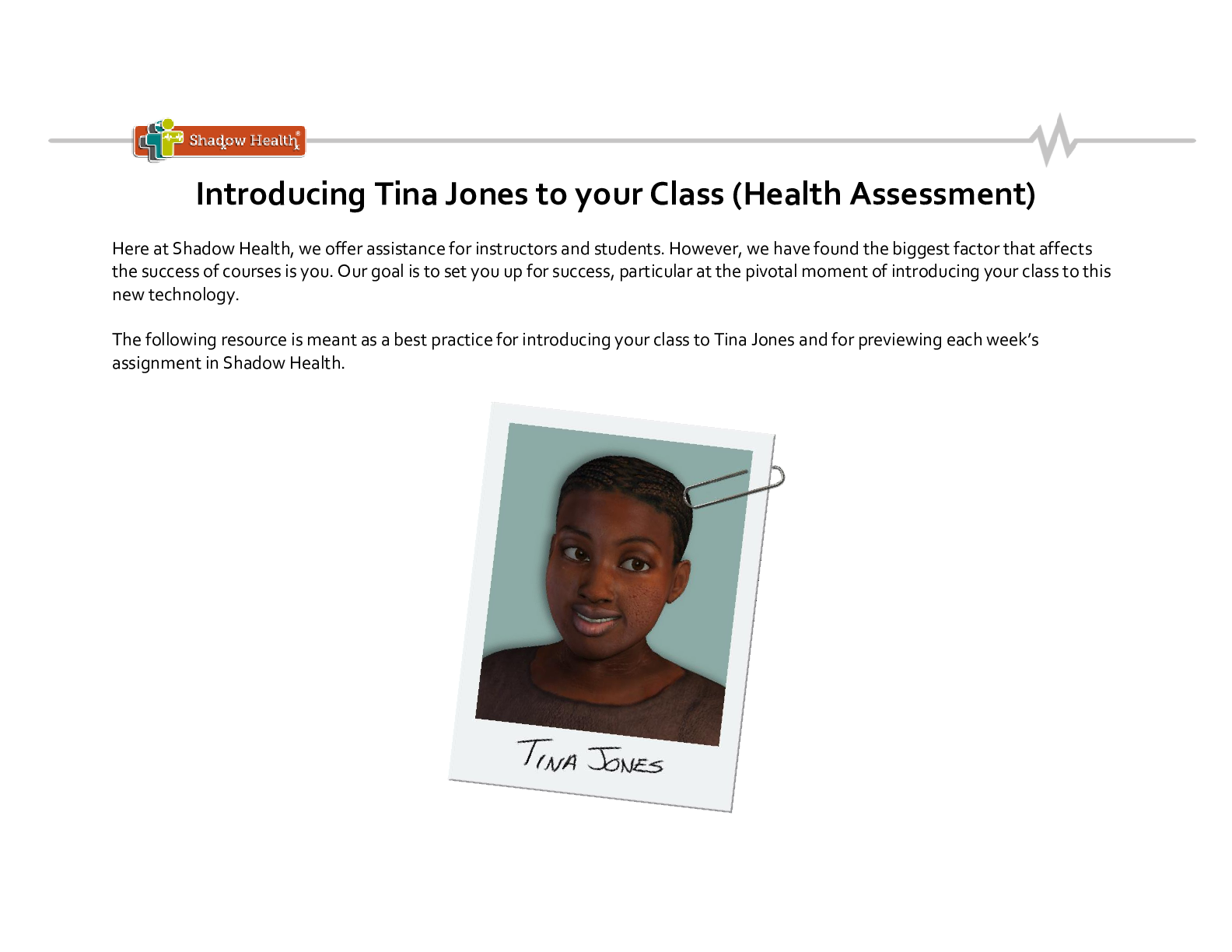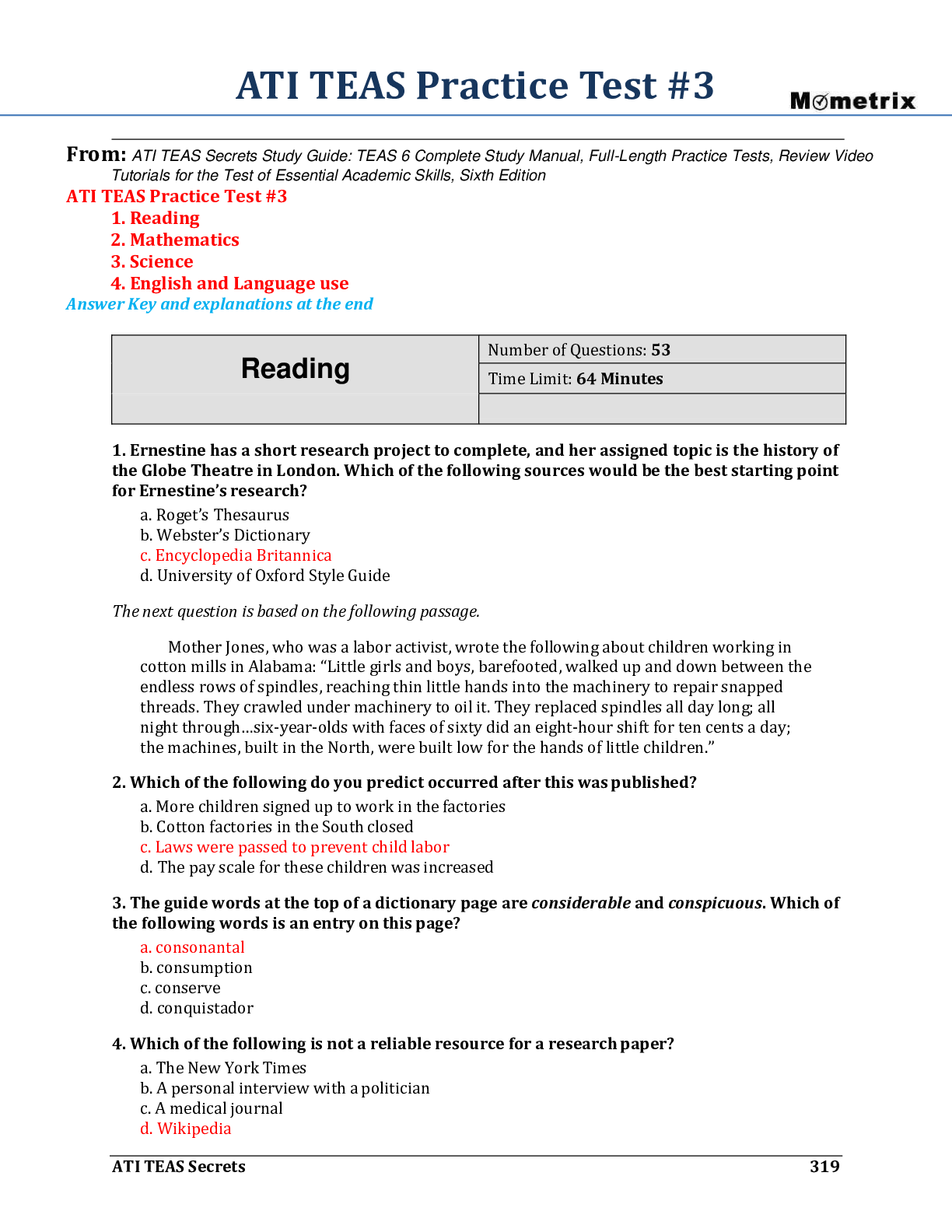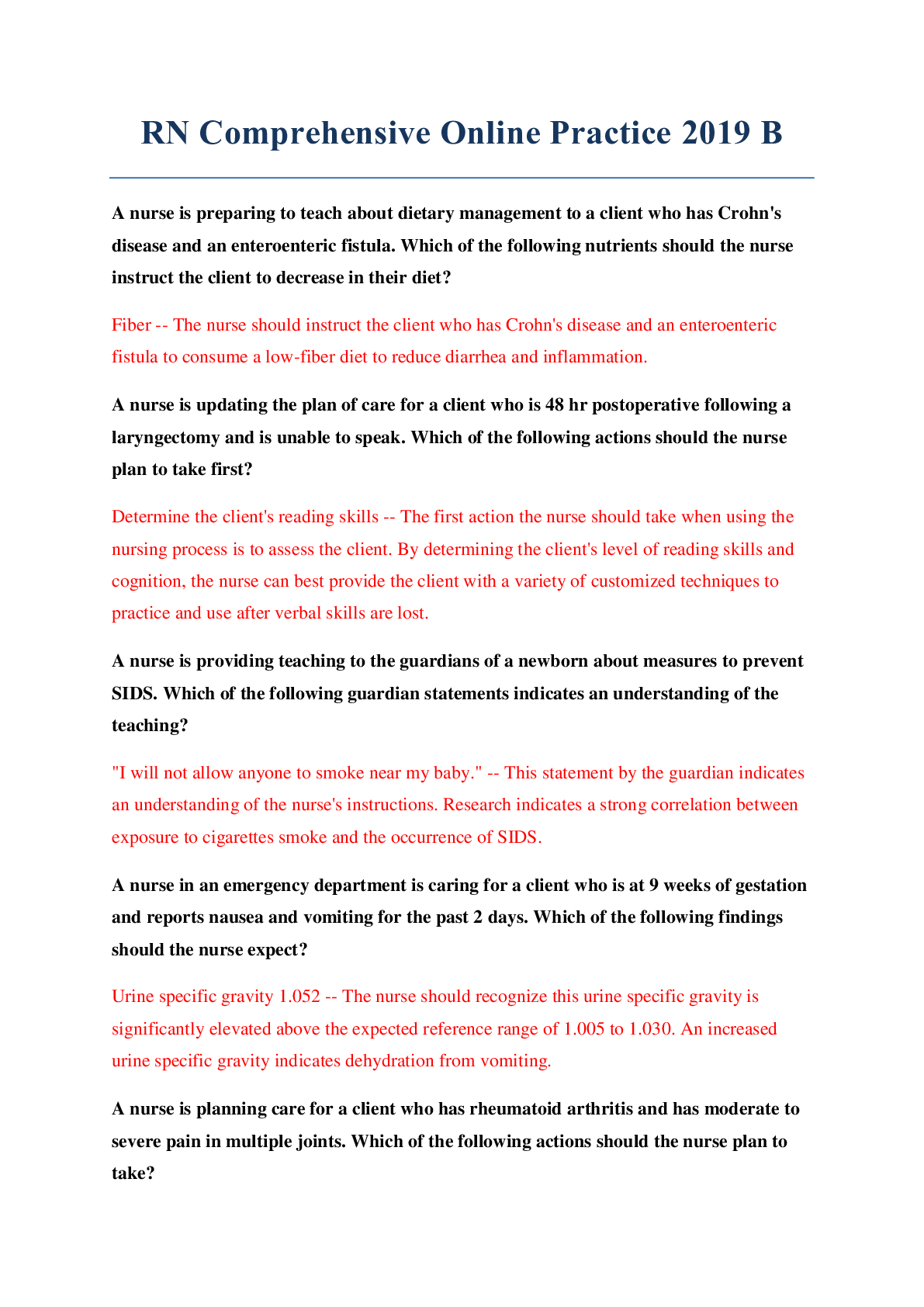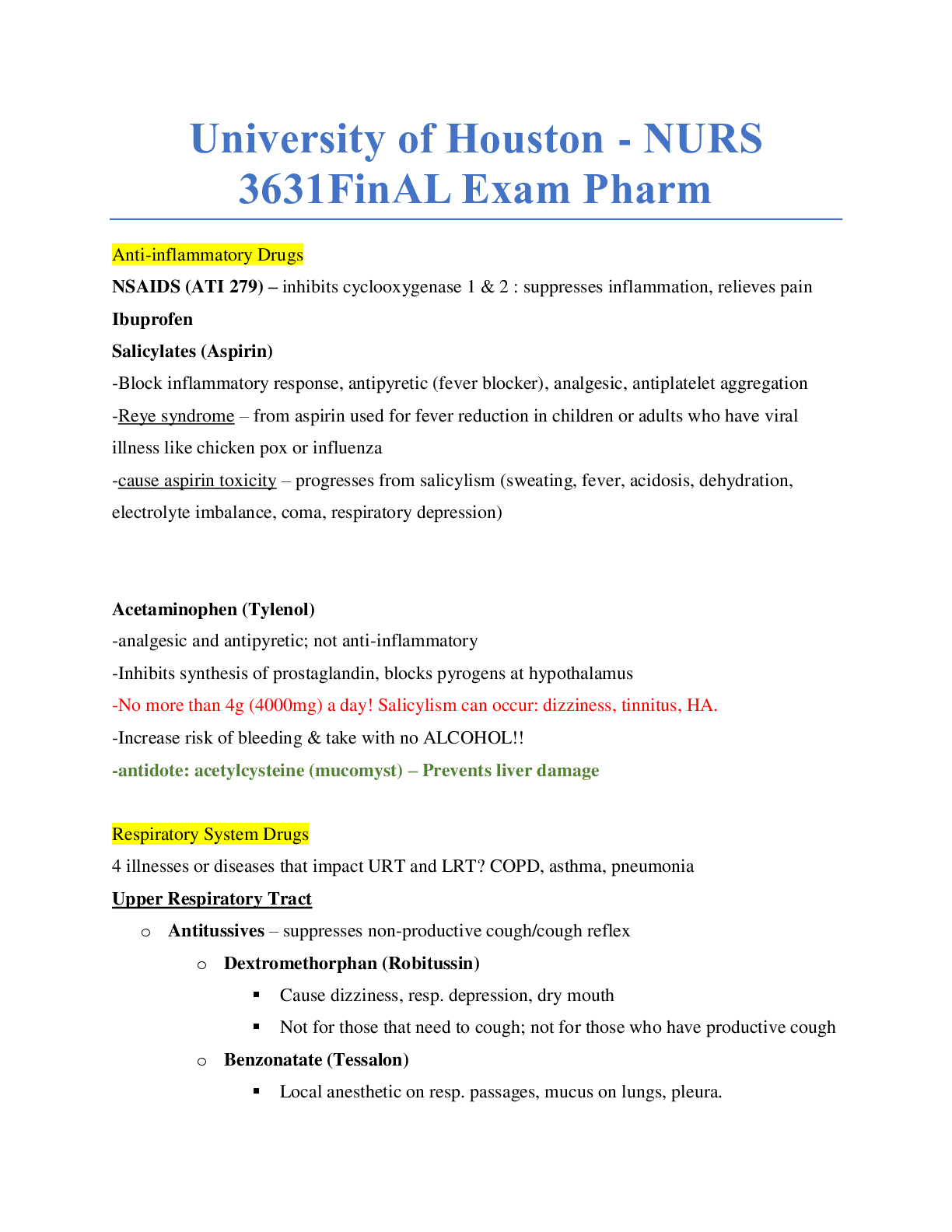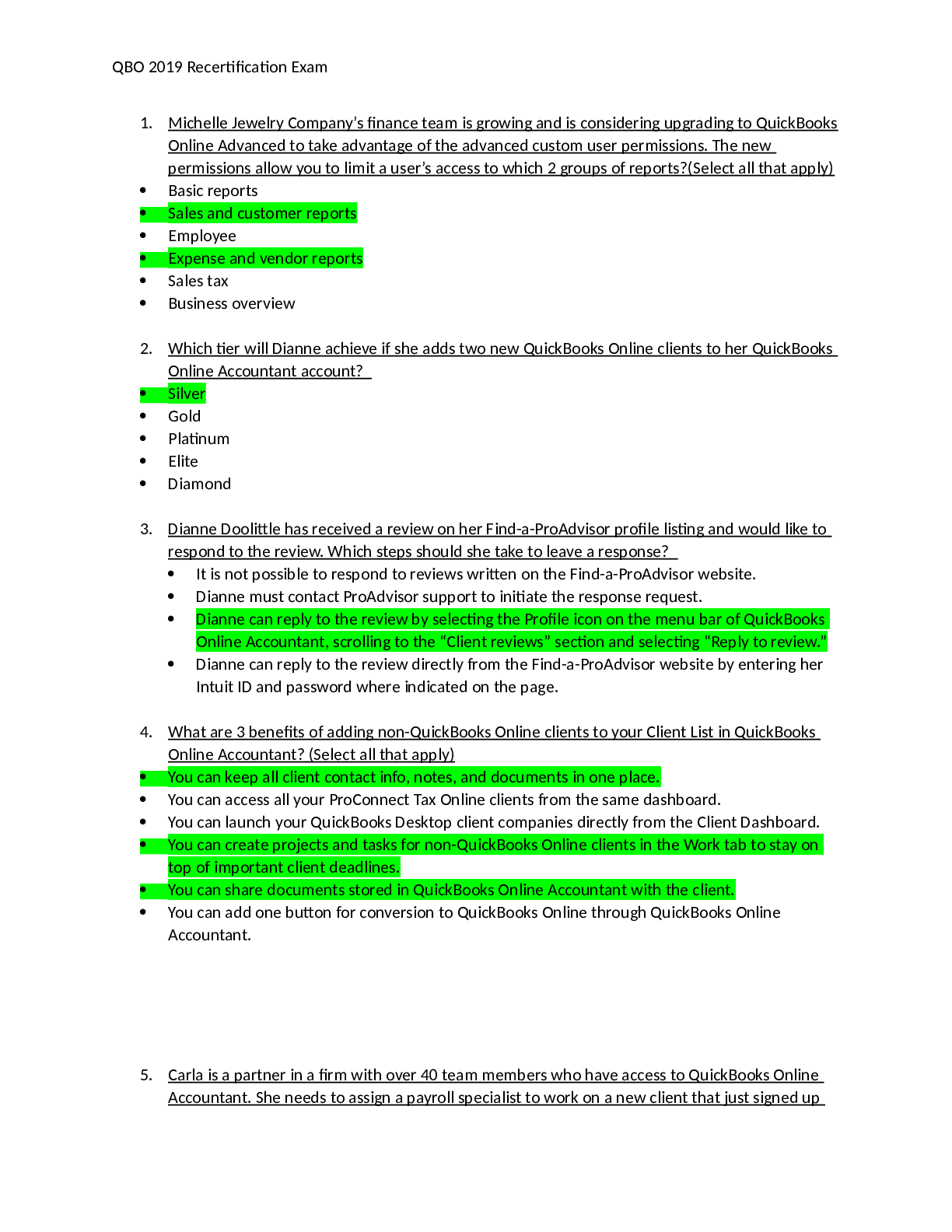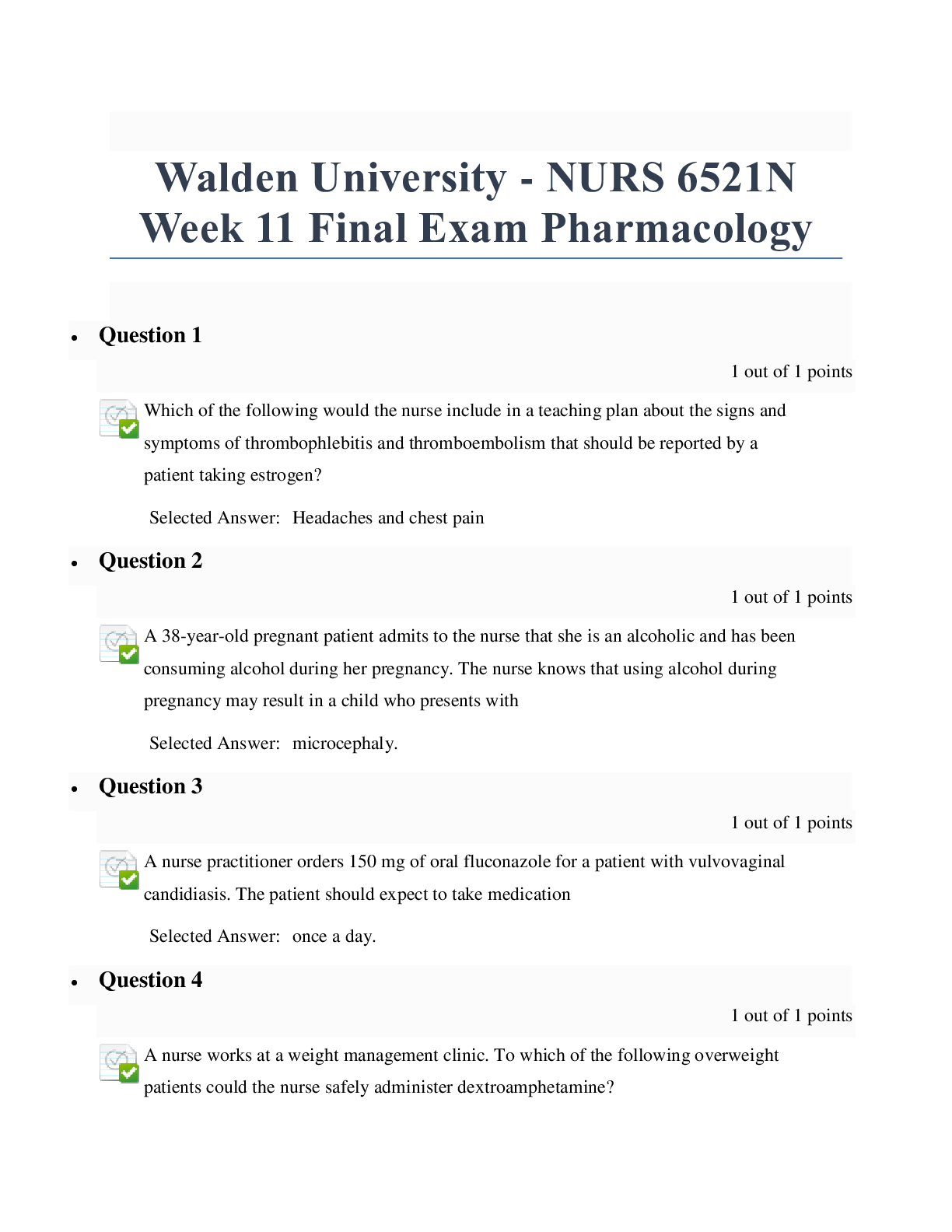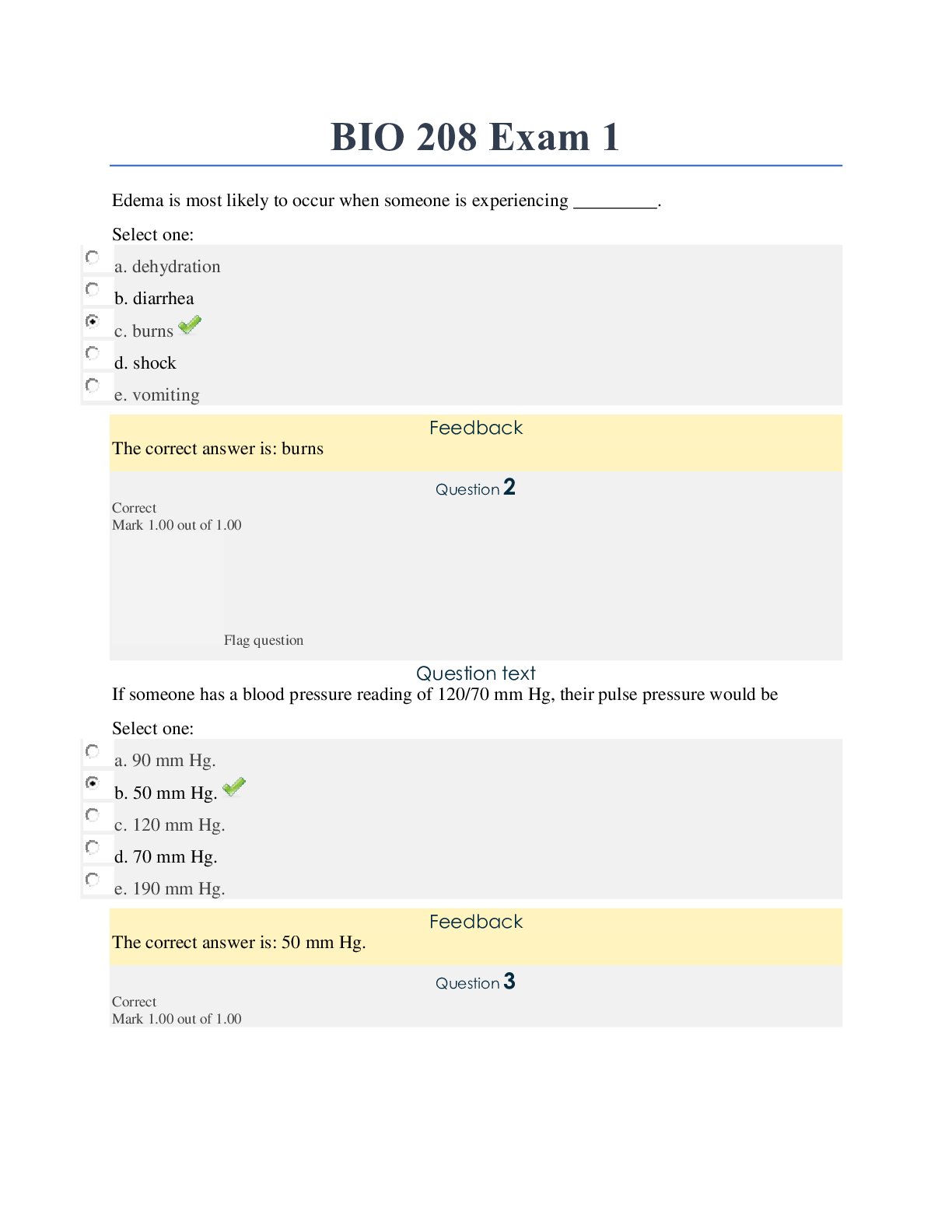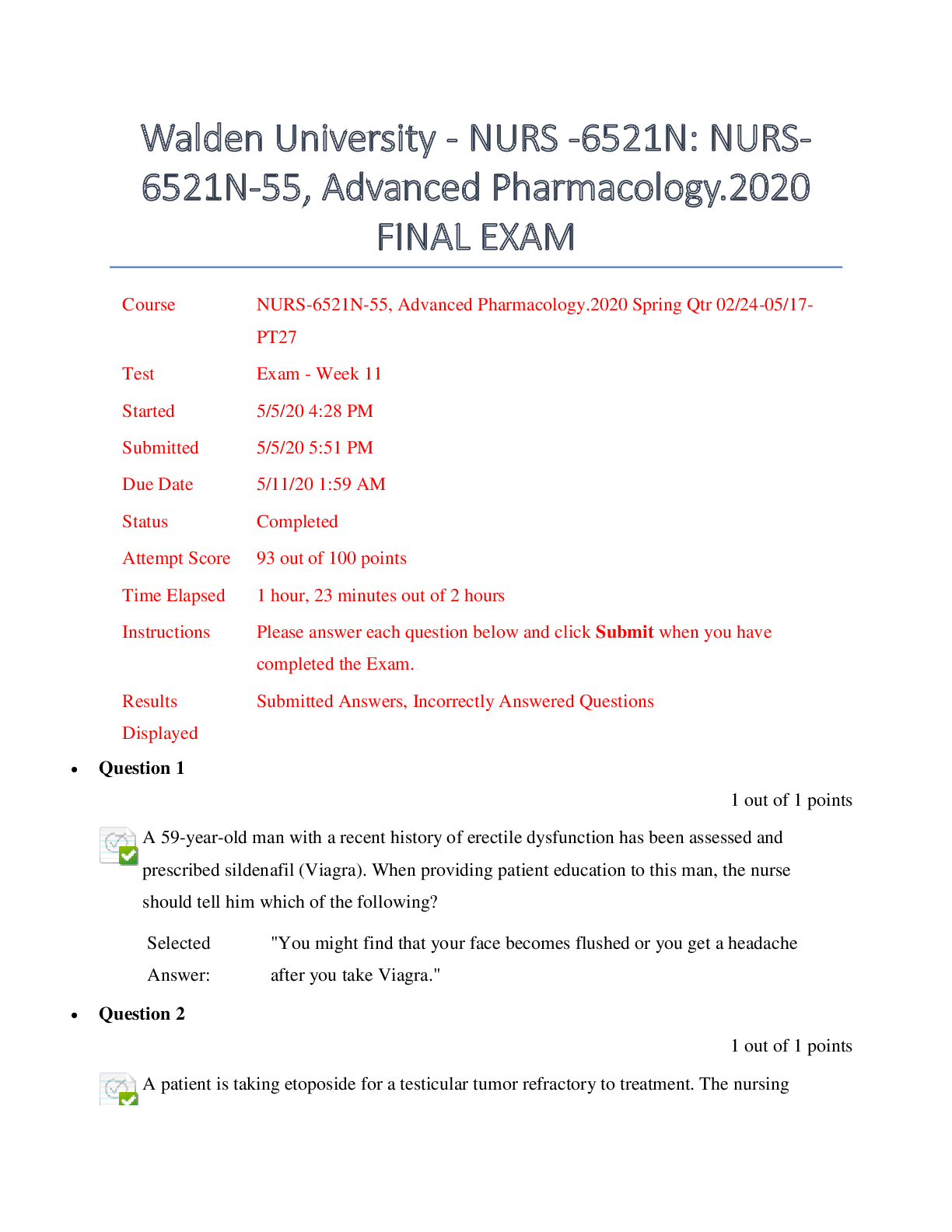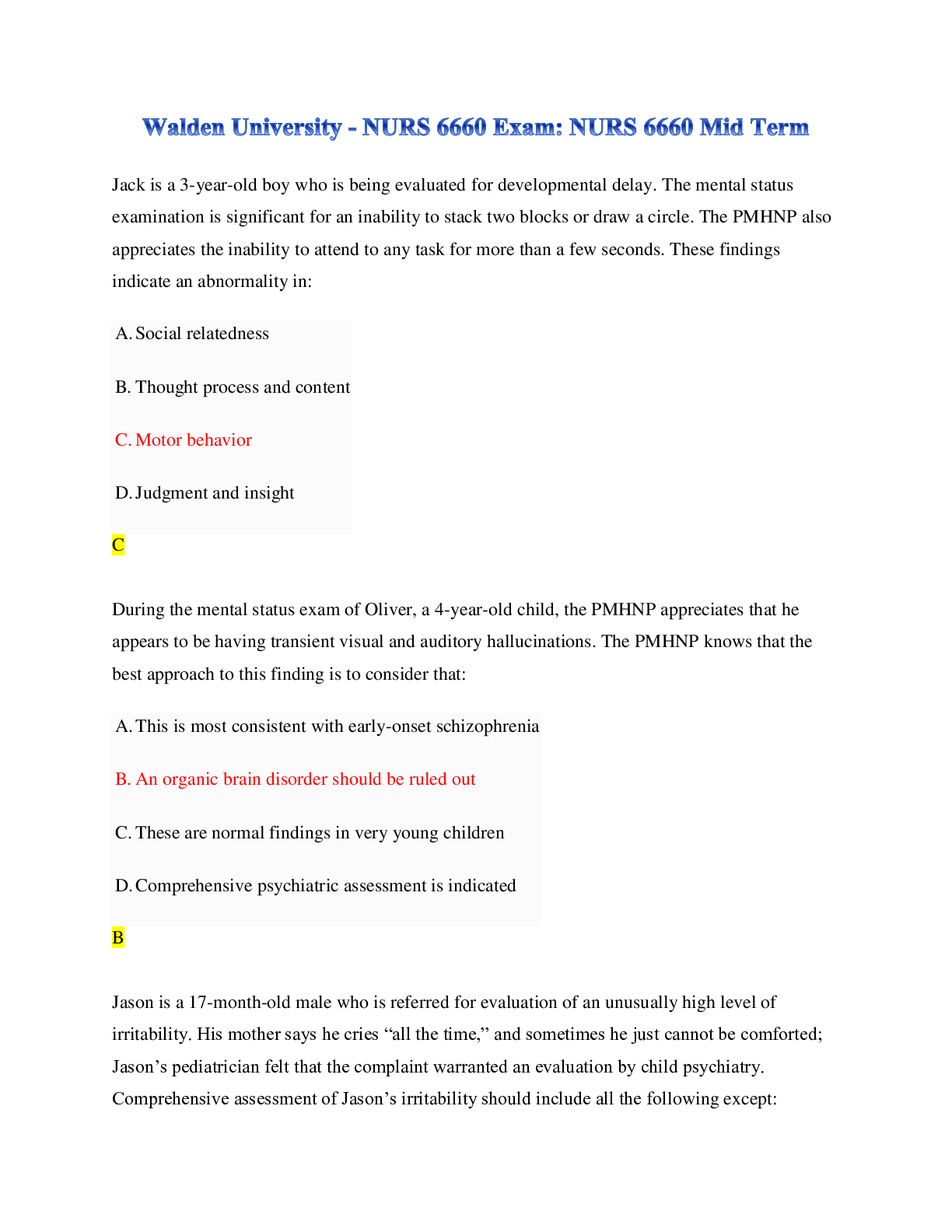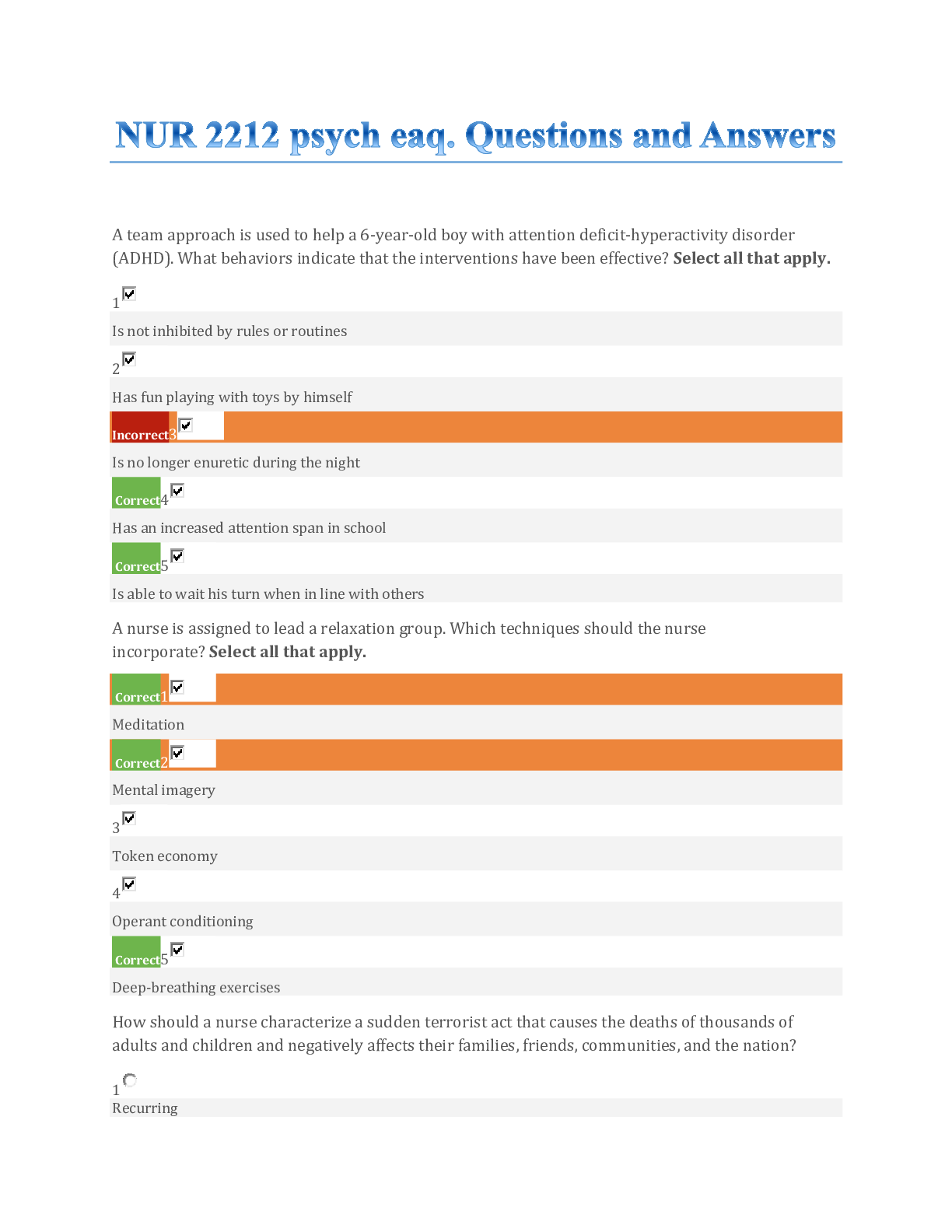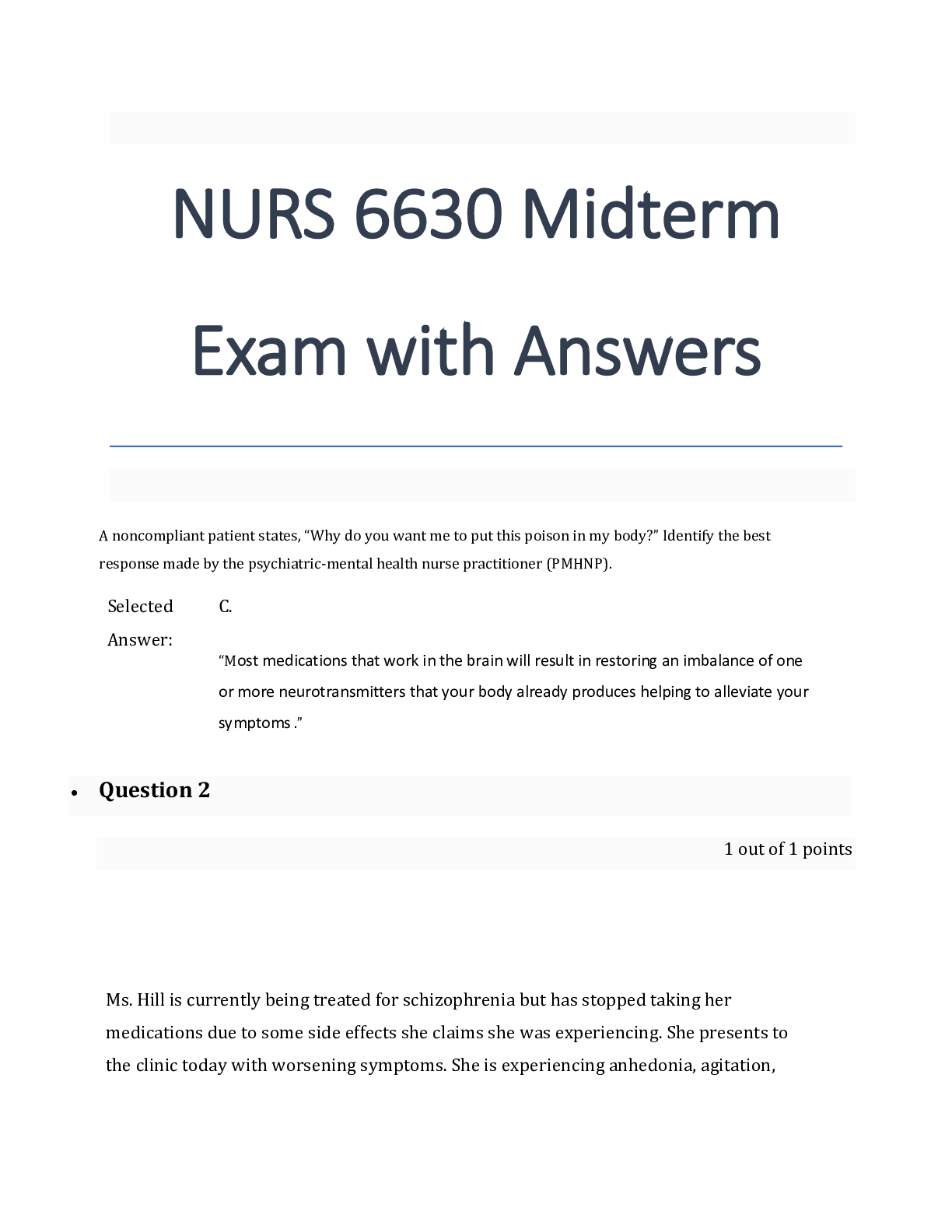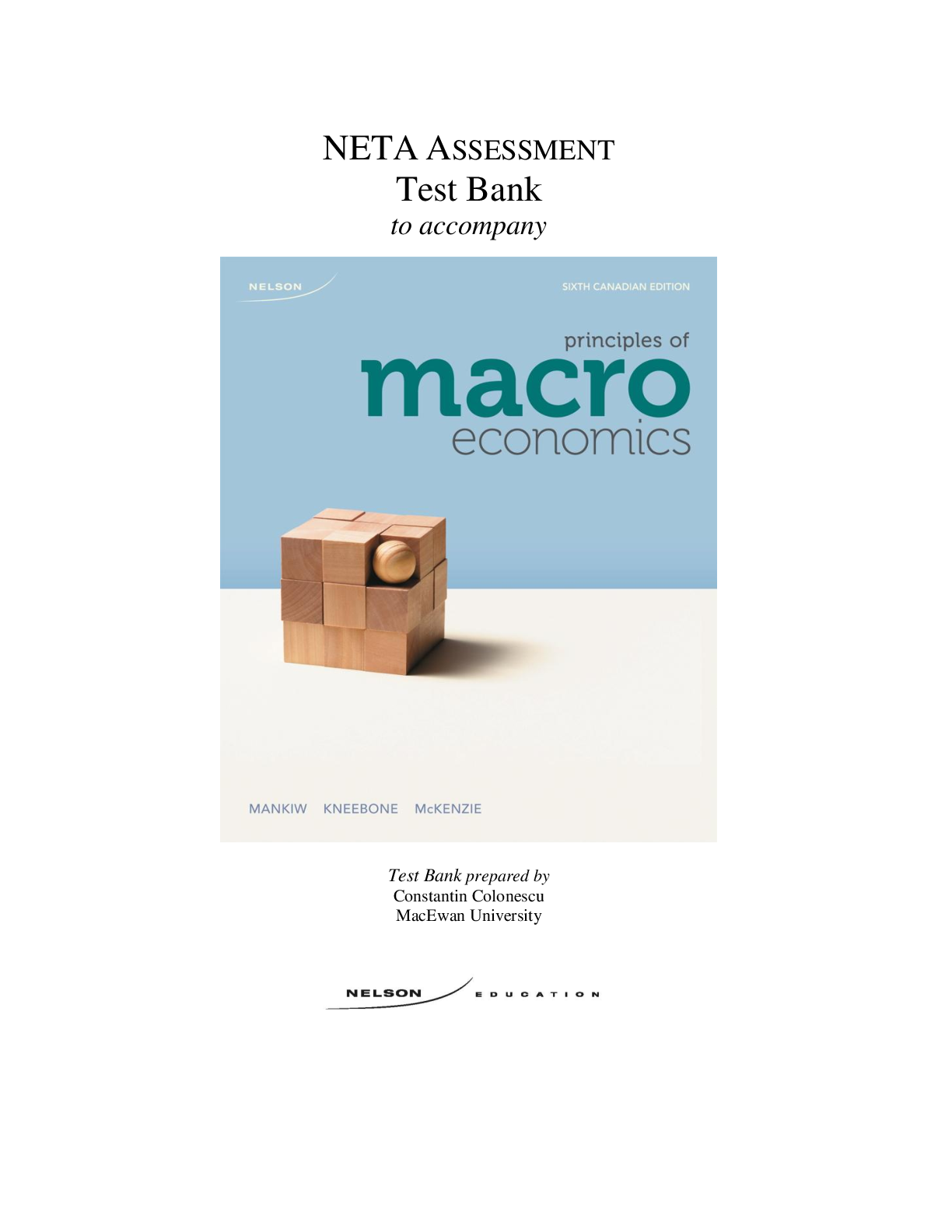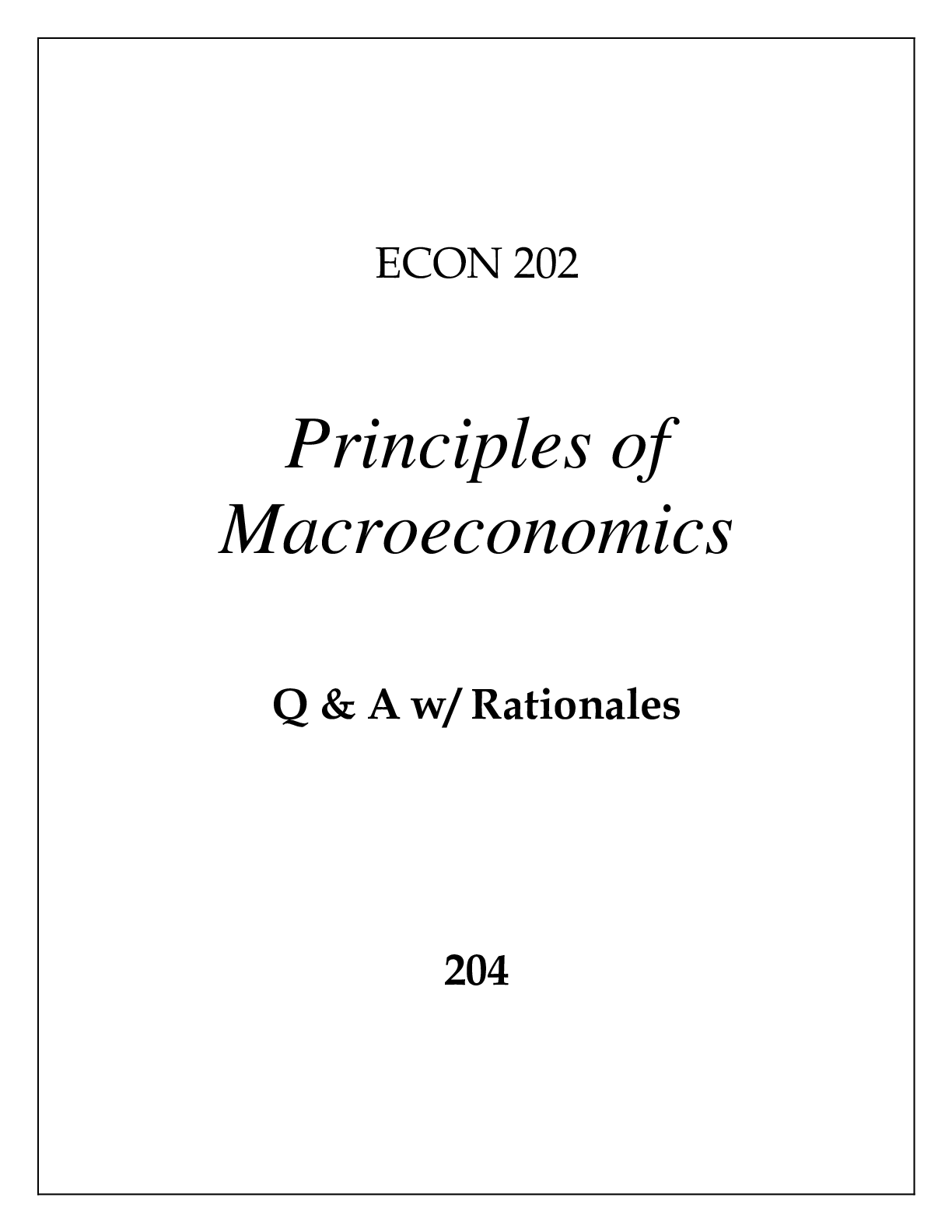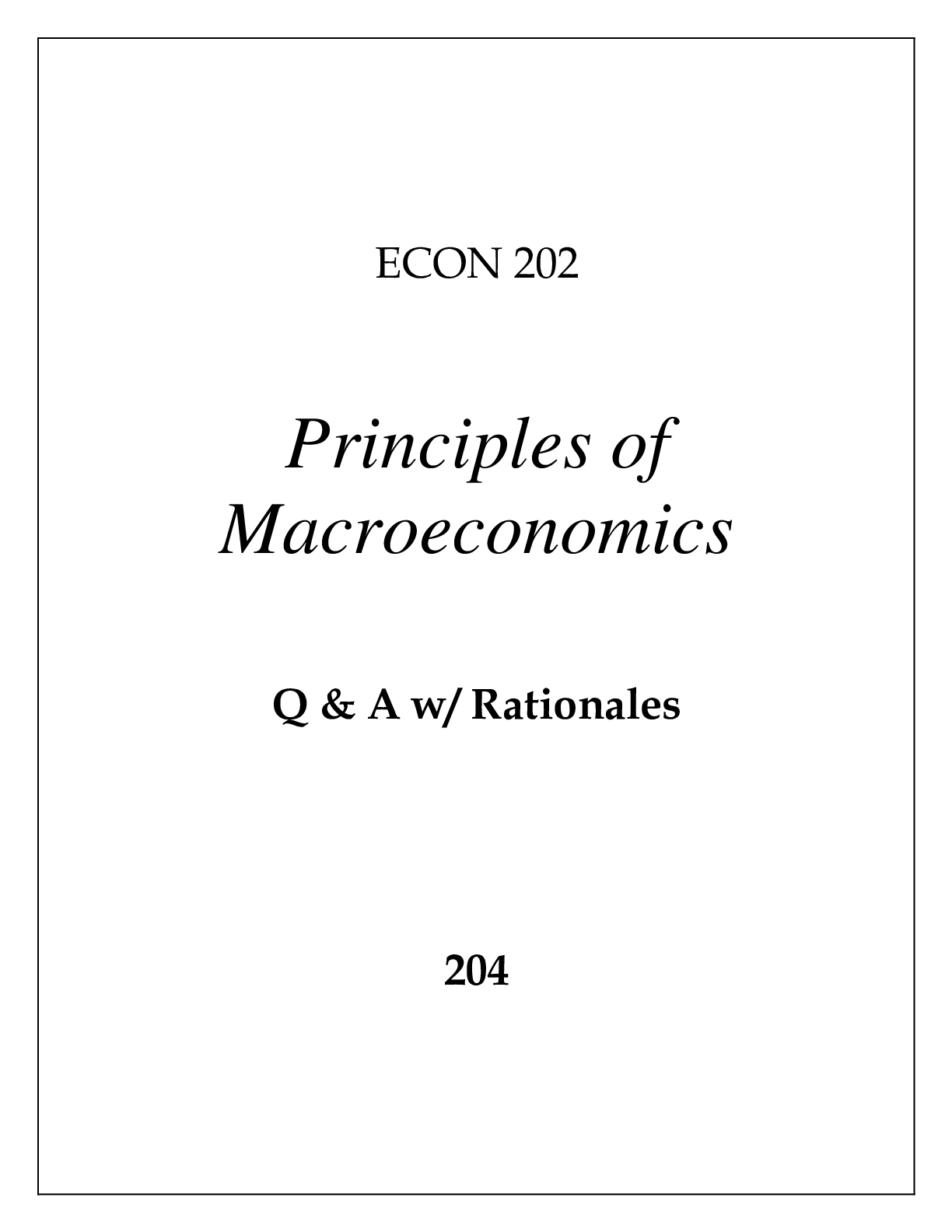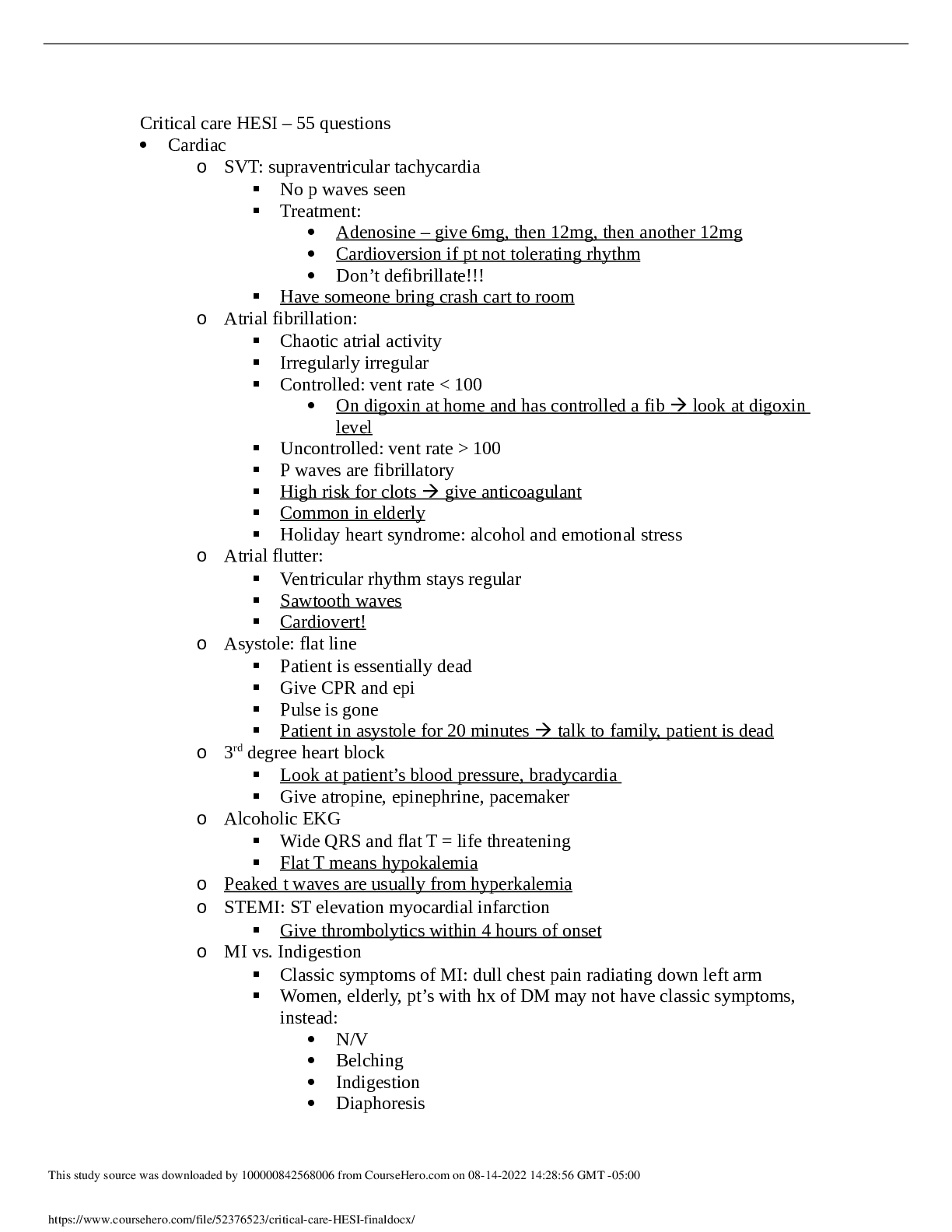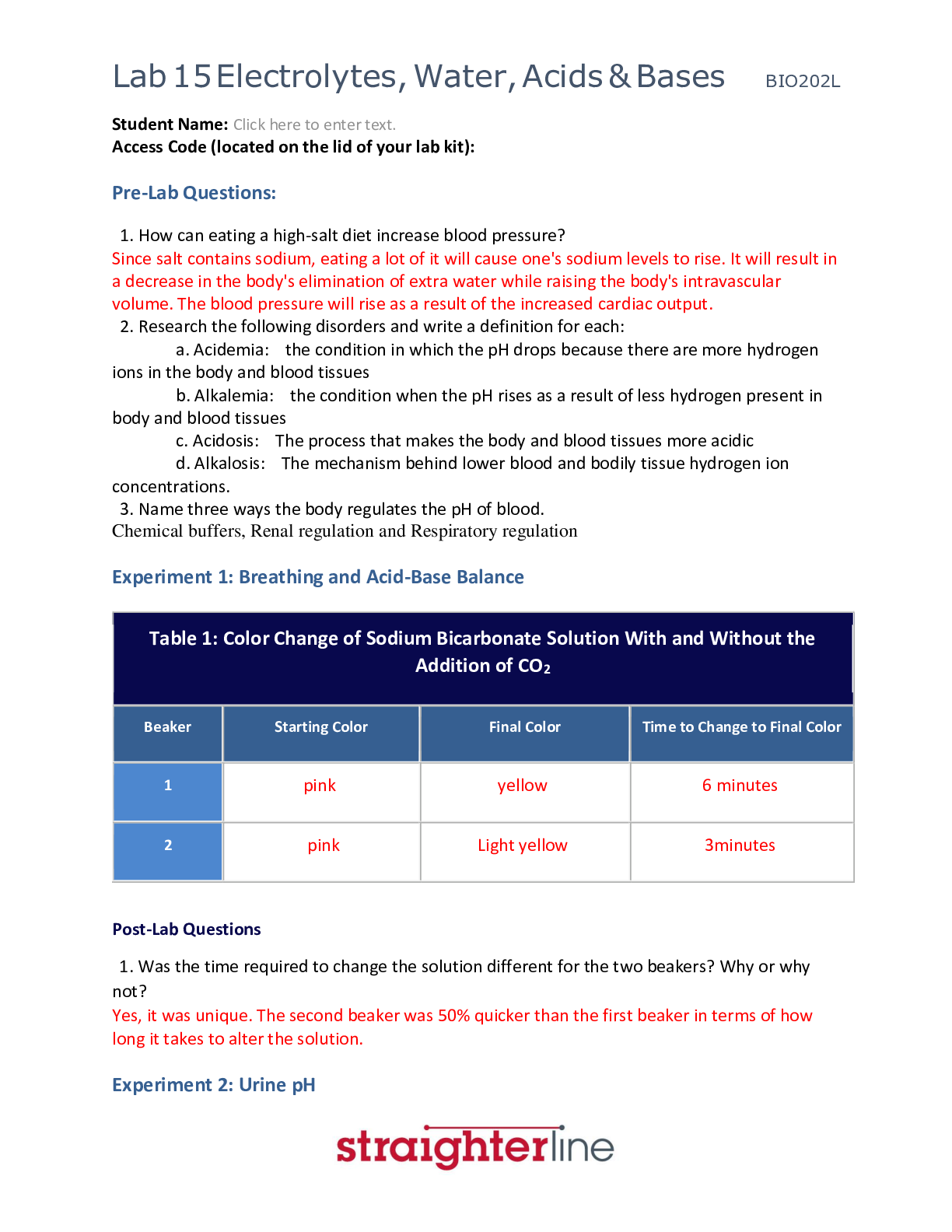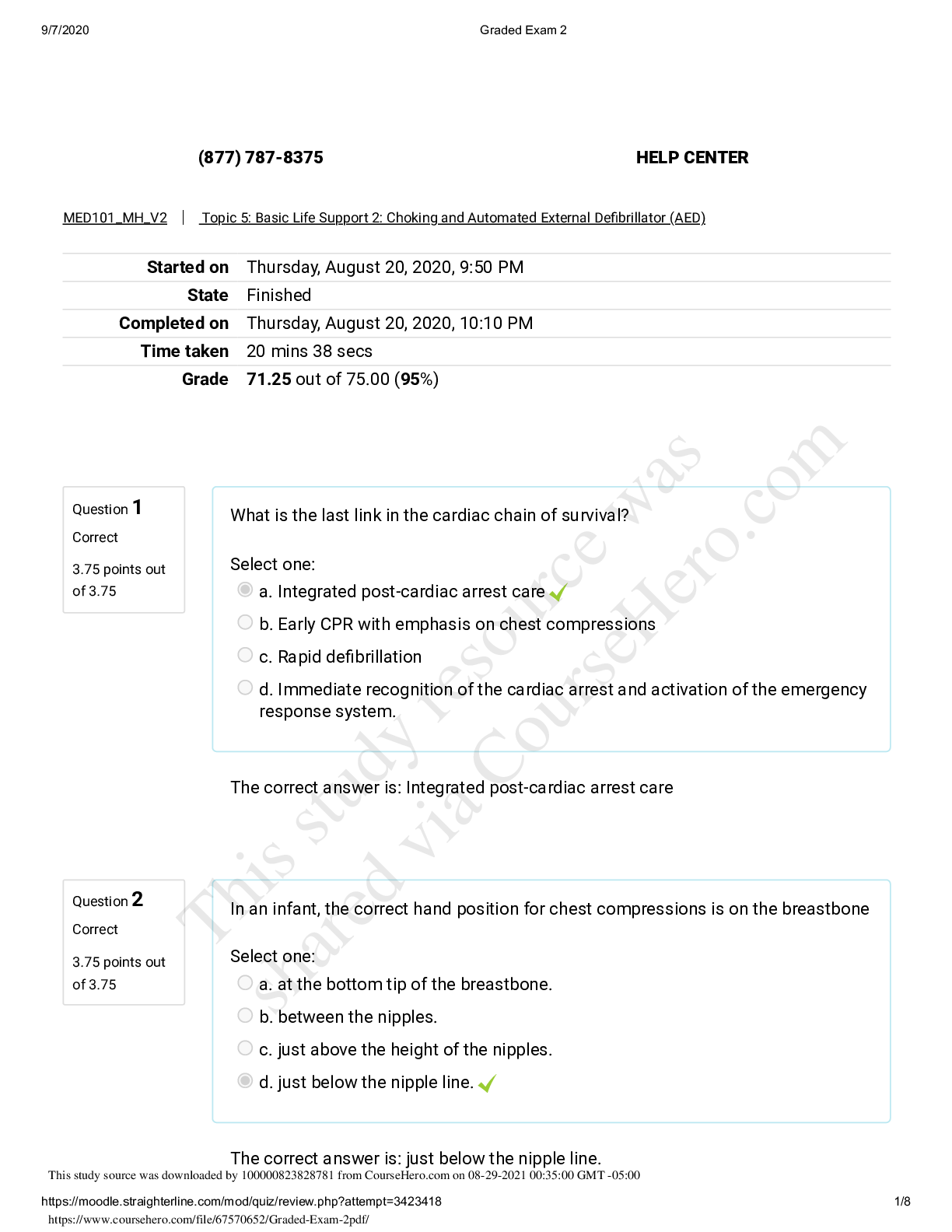ECON 1250: Principles of Macroeconomics All exams, questions and answers
Document Content and Description Below
ECON 1250: Principles of Macroeconomics All exams, questions and answers Introduction to Economics 1. What are the 5 basic questions in determining the allocation of resources? 2. Define ‘ec... onomics’. 3. Explain what a resource is and what the three categories of resource are. Provide two examples of each. 4. Describe the three basic allocation mechanisms. 3 basic allocation mechanisms 5. What is meant by the ‘scientific method’? 6. Explain why economists use models to explain the world. 7. Illustrate the difference between a positive and a normative statement. 8. With the use of examples, distinguish between microeconomic and macroeconomic problems. 9. Briefly explain why people continue to use cell phones when they drive, even though they know that it is illegal. Introduction and PPC 1. Explain why a Production Possibilities Frontier can never be upward sloping. 2. Use a Production Possibilities Frontier to explain the effects of a change in technology on the output of the economy. 3. Use an example to illustrate that you understand the difference between absolute and comparative advantage. 4. Use a Production Possibilities Frontier to explain why a traditional economy was efficient during the Middle Ages. 5. How will the current choice of position on the Production Possibilities Frontier influence the future growth rate of the economy? 6. Explain why governments may be loathe to increase spending on education. Use a PPF in your answer. 7. Use a PPF to explain why Canada is experiencing a higher growth rate than Ethiopia. 8. In the mythical country of Margaritaville, they produce only two products: cheeseburgers and boat drinks. The following table indicates how much of each product each resident can produce in a week. Draw and correctly label the PPF for Margaritaville. Supply Demand 1. If the supply and demand for a particular good can be expressed as follows, what will the amount of consumer and producer surpluses be at the equilibrium price? 2 If there is a devastating typhoon in Sri Lanka, what will likely happen to the street price of cocaine in Vancouver? Explain your answer. 3 Explain why demand curves are downward sloping. 1. If there is a technological breakthrough in the production of an absolute necessity, will this lead to a lower price and larger quantity produced? Explain. 2. List the variables that will cause the supply and demand curves to shift. (5 for each). 3. Wheat and oats are grown under similar conditions and are both used in breads and cereals. What will happen to the quantity of oats grown if the price of wheat were to rise? 4. Explain the relationship between the shapes of the PPF and the supply curve. 5. Both sellers and buyers of gasoline expect that the price will increase tomorrow. What are the likely effects on the equilibrium quantity and price today. Use a diagram in your answer. 6. A recent news report suggested that university enrollment was rising as a result of the recession. Does this imply that education is an inferior good? Explain your answer. 7. Suppose that the market for ice cream cones can be expressed using the following equations. Qd = 2100-300(P) Qs = -100+250(P) What is the total expenditure by consumers on ice cream? 8. If the supply and demand for a particular good can be expressed as follows. Qd = 600 + 100Y - 400P Qs = -200 + 500P Where Y stands for income. Determine the increased expenditure when income rises from 10 to 12. 9. When studying comparative statics, there are eight possible outcomes. What are they? From, class presentation of week 3: Circular Flow 1. Draw and correctly label a circular flow model for an economy with a budget deficit, a trade deficit, a capital account surplus and GDP > GNI. A surplus in the capital account means money is flowing into the country, but unlike a surplus in the current account, the inbound flows effectively represent borrowings or sales of assets rather than payment for work. Here, government takes money from financial market which indicates budget deficit Foreign sector takes money from financial market which indicates trade deficit Resource market takes money from foreign sector, which indicates capital account surplus (not sure of it) again since, GDP > GNI, net factor payments to foreigners. 2. The circular flow model works on the premise that “arrows in equal arrows out”. Explain why this is true for both the firms and the households. 3. Use a circular flow model to explain what Friedman and Schwartz believed led to the depression of the 1930’s. 4. Show how the Production Possibilities curve is related to the circular flow. (from class presentation) 5. What happens to the rate of economic growth when the government runs a budget deficit in a closed economy? 6. What happens to the rate of economic growth when the government runs a budget deficit in an open economy with free capital flows? 7. If there are free capital flows between nations, then all small countries should have the same interest rate. Why don’t they? 8. Use a circular flow model for an open economy to show how the exchange rate between two countries is determined. 9. Why would the Canadian dollar likely rise against the US dollar if Stephen Poloz decided to raise the target rate for overnight money? Measuring the Economy 1. List the components of GDP for both the expenditure approach and the income approach. 2. The Consumer Price Index for September 2013 was 115.7 (2002=100). The same index was 111.9 in September 2014. What was Canada’s inflation rate for that period? 3. List 4 of the 5 different types of unemployment. What are their causes and their cures. Seasonal unemployment: Unemployment that occurs at the same time every year (teachers) Frictional Unemployment: 4. What is the relationship between the GINI index and the Lorenz curve? What are they used for? 5. State and define the four elements of Consumption in national income accounting. 6. Ford Canada builds a new F150 pickup truck in its Ontario plant. Explain how this may be counted in national income accounting. 7. Do the income approach and the expenditure approach to national income accounting always equal each other? Explain your answer. 8. Explain 4 reasons why GDP is not a good measure of national welfare 9. Define the “Labour Force”. All persons, age 15 and over, that are willing and able to work, excluding: 10. What is the difference between ‘frictional’ and ‘structural’ unemployment? Use an example in your answer. Frictional Unemployment 11. Explain what is meant by efficiency wages and why they may lead to unemployment? Efficiency Wages - Employers paying above equilibrium wages 12. Explain what is meant by the Natural Rate of Unemployment. 13. What is the relationship between GDP and the unemployment rate? 14. What is the difference between cost-push and demand-pull inflation? How would we be able to distinguish between the two? 15. State and explain 4 costs of inflation. 16. What is the Fisher Effect? Economic Growth and Aggregate Supply 1. Draw the Solow growth model for a “catch-up” economy. 2. Does the Solow growth model predict that the real GDP of an economy will eventually stop growing? Explain your answer. 3. Use either the Production Possibilities Curve or the Solow growth model to explain how an economy can grow over time. 4. Use the Solow Growth Model to explain the effects of an increase in the average propensity to save. 5 Show how a change in technology affects the steady state in the Solow model. Explain the adjustment process. 6. Explain how the Aggregate Supply curve and the Production Possibilities Boundary are related. Aggregate Demand 1. What are the determinants of desired consumption spending? Income, Savings, Taxes 2. Explain why the Keynesian consumption function may not be utility maximizing. 3. Show how an unexpected increase in income affects consumption differently in each of the Modigliani and Friedman models. 4. What is the fundamental difference between the Keynesian, Life-Cycle and Permanent Income models of consumption? 5. What would happen to desired investment spending if the rate of depreciation increased? Explain. 6. What are the major determinants of net exports? Net exports is determined by: 7. State and explain the three reasons that the Aggregate Demand curve is downward sloping. 8. With the use of an AS-AD diagram, illustrate the effect of a US recession on the Canadian unemployment rate. MONEY AND BANKING 1. State and explain the three use of money. : 1. Unit of account: Money is the common standard for measuring relative worth of goods and service. 2. What are the 6 characteristics that a commodity must possess to function as money? (learning objective 10.1, from Textbook) (from class presentation) Top six qualities of an ideal money material are: 3. Use an example to clearly demonstrate that you understand the difference between brassage and seigniorage. 4. Use an example to illustrate Gresham’s Law. 5. Derive the transaction demand for money from the Quantity Theory of Money. 6. How does the Cambridge Approach differ from the Quantity Theory of Money? Which predicts the more elastic demand for money? 7. What is a liquidity trap? 8. What are the major functions of the Bank of Canada? 9. Show how a $100 increase in the monetary base affects the money supply if the target reserve ratio is 10%. 10. Explain the shape of the money supply curve in Canada, and why it is that way. EXCHANGE RATES 1. Indicate the variables that influence the exchange rate and state in which direction they change the exchange rate. 2. Show that you understand the Purchasing Power Parity Theorem. (from textbook) 3. Explain what happens to a fixed exchange rate when a country runs out of foreign reserves. FISCAL AND MONETARY POLICY 1. In theory, why does a $100 million increase in government spending have a greater stimulative effect than a $100 million tax cut? From textbook 12.4 learning objectives 2. Use an AS-AD model to show the effect of expansionary fiscal policy. (from textbook) 3. Show how an increase in the government’s budget deficit may crowd out private spending. 4. Why would have Keynes suggested to President Roosevelt that he fund the construction of pyramids in the US during the depression? 5. List all the conditions in the Keynesian monetary transmission that must be true for monetary policy to be effective. 6. How does a change in the Bank of Canada’s target overnight rate influence the Aggregate Demand Curve? (learning objective 11.3) 7. Does monetary policy work better with flexible or fixed exchange rates. Explain your answer. 8. List and explain 4 lags the exist when using fiscal policy. recognition lag, decision lag, implementation lag and take-effect lag. [Show More]
Last updated: 1 year ago
Preview 1 out of 34 pages
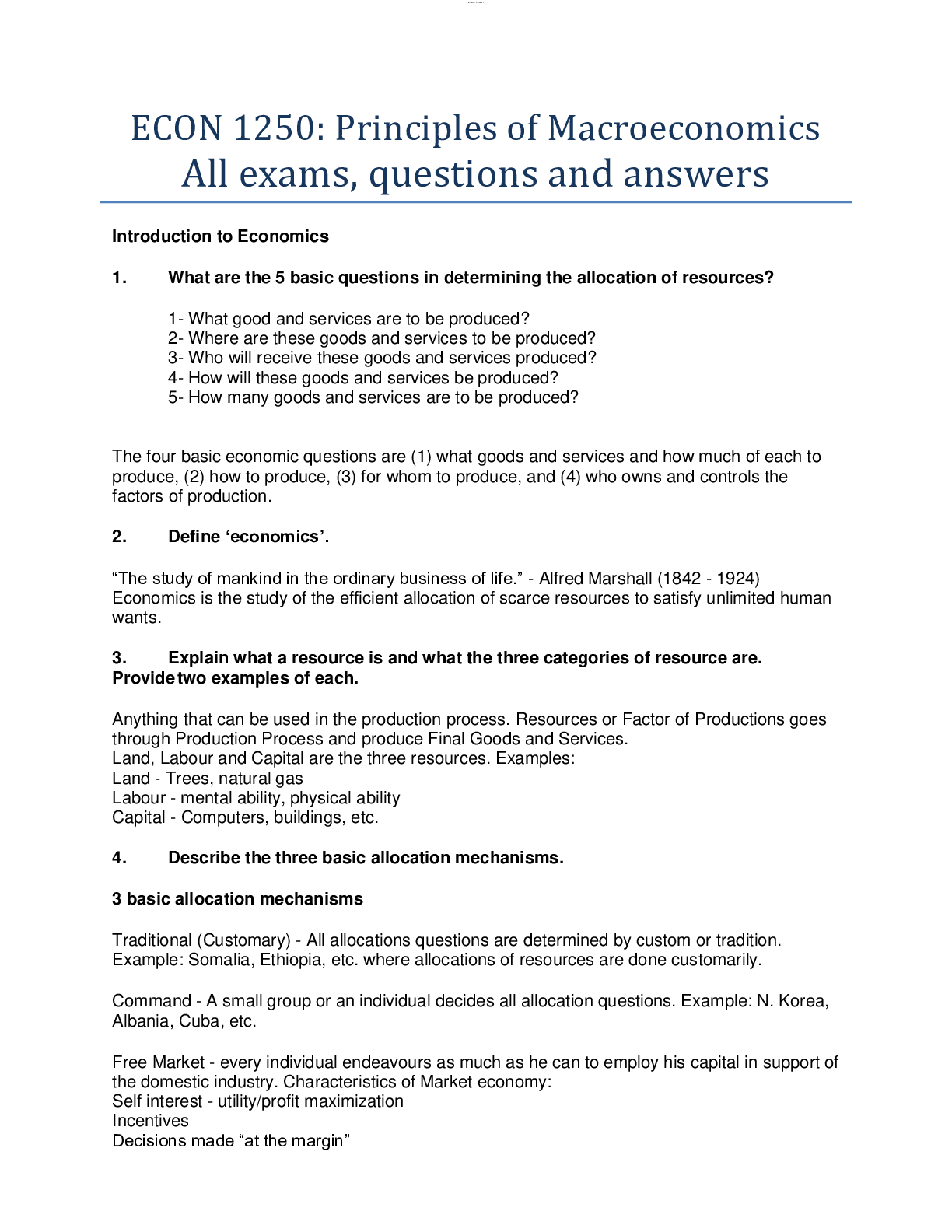
Reviews( 0 )
Document information
Connected school, study & course
About the document
Uploaded On
Jun 21, 2020
Number of pages
34
Written in
Additional information
This document has been written for:
Uploaded
Jun 21, 2020
Downloads
0
Views
265


